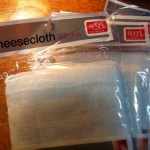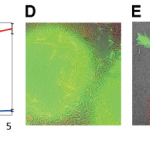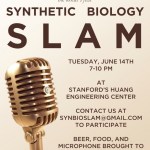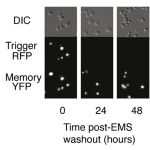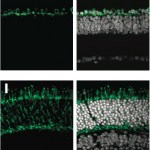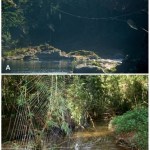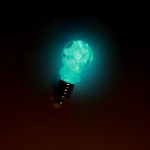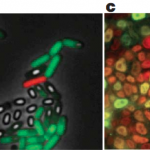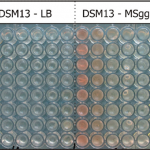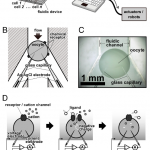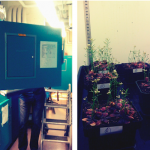synthetic biology
Today we get to the science and the issues surrounding it. Karl Deisseroth gave the first keynote lecture. For anyone who's been asleep the past few years, Deisseroth's lab at Stanford is at the cutting edge of a new kind of brain research. They invented optogenetics -- turning brain circuits on and off (in mice, at present) with fiberoptic lasers. Their lab is putting out new methodology at an astounding rate. Their latest is Clarity: a way of making the brain tissue clear, so you can see all the neurons at once. In other words, you can get an image of the whole brain. I know I am not the…
New online articles this week highlight two forays into the world of synthetic biology. Each, in its own way, gives a different perspective on how sophisticated the field has become in the past few years, since smiley-face DNA was first introduced.
Prof. Benjamin Geiger of the Weizmann Institute and Prof. Joachim Spatz of the Max Planck Institute for Intelligent Systems, Germany are leading an unusual collaboration. One is a biologist, the other a materials scientist. Together, they are working on models that incorporate the whole gamut from completely man-made materials to 100% biological…
I'm making my way up to SB 5.0 for what promises to be a great conference. If you're going too, come say hi and smell some cheeses during the poster session!
Last month I wrote about my friend Devin Burrill's paper about synthetic memory in yeast cells. There were a lot of really interesting questions left in the comments, and I asked Devin if she would write a guest post to answer them. She agreed and here it is, answers to your questions straight from the author!
Hello Readers!
My name is Devin, and I am so incredibly grateful to Christina for allowing me to write an entry on her awesome blog. Christina and I are friends and work together in the lab of Pamela Silver at Harvard Medical School. I am writing in response to a number of excellent…
Two videos that Patrick Boyle and I made were selected for the Bio:Fiction Film Festival! One of the prizes is an online audience award, and you can watch and rate all of the films! It's such an honor to be part of this festival and to be showing our work next to that of so many amazing artists, scientists, and filmmakers, and we would be super thrilled if you voted for us!
Here are our videos! First, the world premiere of Compound 74, a fictional documentary about a possible future of synthetic drug design through synthetic biology:
And second, the commercial we made for Ginkgo BioWorks--…
Symbiosis is everywhere. From the Greek for "living with," symbiosis is simply a close association between two different species in nature. These relationships can be mutualistic, parasitic, or somewhere in between. Bacterial symbionts live inside bodies, like the bacteria that help us and other animals digest our food, and they live inside cells, like the bacteria that live in plant roots and provide their hosts with nitrogen. They can be metabolic, hygienic, or photosynthetic; ectosymbiotic, on the host surface, or endosymbiotic, inside the host's cells. Back in the 1860's biologists…
Before you get your tickets for SB 5.0 make sure that you'll be in town for the world's first Synthetic Biology Slam!
Cells permanently change their behavior in response to temporary changes to the environment, a kind of biological memory that controls processes as important and complex as how stem cells differentiate into specific tissues or how the immune system "remembers" dangerous pathogens. At its simplest, cellular memory is achieved with a positive feedback loop--once activated by some external signal, the feedback loop will continually activate itself, even as the cell divides and the signal is taken away. In synthetic biology we can recreate such simple feedback loops, genetic circuits built of…
I had a great conversation with Maggie Koerth-Baker from BoingBoing for bloggingheads.tv Science Saturday. We talked about all sorts of sciency stuff, including her upcoming book on the challenges of renewable energy, synthetic biology, the similarities between cheese and the human body, women in science/blogging, and octopus brains. I had a lot of fun chatting with Maggie and I learned a lot, and I hope you will too!
Synthetic biologists work on designing living cells, but engineered bacteria don't usually come up when you think of "designer" things. This year however, a synthetic biology design is up for a Brit Insurance Design of the Year award, up against the Lanvin Spring collection, Angry Birds, and Rock Band 3! Designers Daisy Ginsberg and James King worked in collaboration with the 2009 Cambridge iGEM team (including awesome blogger Lab Rat) to imagine ways that people could use bacteria engineered to produce pigments in the future. Check out their video about the science and design of E. chromi:
What do you get when you combine two of my favorite things, synthetic biology and documentary film? We may never know if Sam and George don't get the funding they need on Kickstarter!
I don't usually do this kind of thing, but I met these guys while they were filming in Boston and their movie promises to be really good and really interesting and really educational (and I might even be in it!). You can check out some of their videos from the road on their vimeo page, including this one from the University of Wisconsin iGEM team:
Evolution connects all living things on earth, from the arsenic tolerant bacteria in the news this week to the human scientists and bloggers chatting about it. Eyes are intricately complex structures made up of many many cells, but even single-celled microbes can sense and respond to light through the function of proteins that share evolutionary similarity with the light receptors of the human retina. Incredibly, genetic engineering is showing us just how similar these proteins can be--transferring the genes that code for these processes leads to functional proteins, even when huge…
iGEM students are nothing if not creative, fun, and super nerdy. Here is a taste of some of the awesome videos being made by this year's crop, enjoy!
Cambridge, with a catchy song about new techniques for joining pieces of DNA together:
(via LabRat)
Hong Kong University's Inception trailer:
TU Delft, finding science in pop music:
And of course, Harvard, being dramatic in the lab:
There was some big news yesterday in transgenic silk from Notre Dame and the University of Wyoming, where scientists have genetically engineered silkworms to produce silk that is a mixture of spider silk and the regular silkworm stuff. Silkworms produce the strong and versatile silk that is used to make clothes, but spiders produce silk that can be much stronger and much more elastic. Spiders, however, don't like to be grown in huge factories and don't make easily harvested cocoons like silkworms, so gathering even small amounts is very difficult (here's a fun how-to for collecting spider…
Our friends at Ginkgo BioWorks are hiring and they asked Hydrocalypse Industries to make them a video! Who Is the Bioengineer of the Future?
It could be you!
This year's Cambridge iGEM team has made a tiny, wireless lightbulb filled with bioluminescent bacteria! There are two main ways of engineering luminescence in E. coli (I assume these are E. coli, correct me if I'm wrong!). One is to express the luciferase gene from fireflies, which adds ATP and oxygen to the chemical luciferin, producing oxyluciferin and yellow, green, or red light.
Since the lightbulb is blue, this bacteria is probably expressing the Lux operon from Vibrio fischeri, which use their bioluminescence in an awesome underwater symbiosis. From the Cambridge iGEM wiki:
Some…
Noise obscures meaningful information. Noise is what ruins your carefully designed synthetic biology gene circuit. But noise is part of life and life, it turns out, needs noise. There's a terrific review article in this week's Nature discussing recent theoretical and experimental work on biological noise showing functional roles for molecular, genetic, and evolutionary noise.
From the abstract:
The genetic circuits that regulate cellular functions are subject to stochastic fluctuations, or 'noise', in the levels of their components. Noise, far from just a nuisance, has begun to be…
Cells are constantly jibber jabbering, sending messages to each other to coordinate behavior, both within a population of single-celled organisms or between cells of an individual multicellular organism. Most of these signals are chemicals that float around in the liquid that surrounds the cells but there recently has been an increased appreciation for cells' sense of "smell"--how cells respond to chemicals that are present as gasses.
A brand new paper outlines the discovery of "olfaction" in a species of bacteria, Bacillus licheniformis. Trying to save space on a 96 well dish by putting…
A lot of synthetic biology is about getting biology to be more like electrical engineering, designing genetic "logic gates" to create a living circuit board. Beyond analogies, however, cells have many fascinating electrical properties--proteins that transfer electrons like wires, membranes that separate ions and create an electrical charge that drives the metabolism of the cell, channels through these membranes that open and close to activate an electro-biological response. Electrons are electrons whether they are in proteins or copper wires, and many scientists have designed ways to connect…
Sometimes among all of the tedious protocols and mundane inconclusive data, I forget that I'm doing something amazing and incredibly powerful. Almost all my experiments require altering a living organism to do my bidding--to hold onto and replicate a piece of DNA that I'm interested in or to produce an enzyme that I want a lot of. Thanks to iGEM this summer I've gotten to learn some new soon-to-be-tedious protocols that seem absolutely thrilling now, and the experience is reminding me of how awesome (in the real sense of the word) genetic engineering is.
The team is working with the model…


